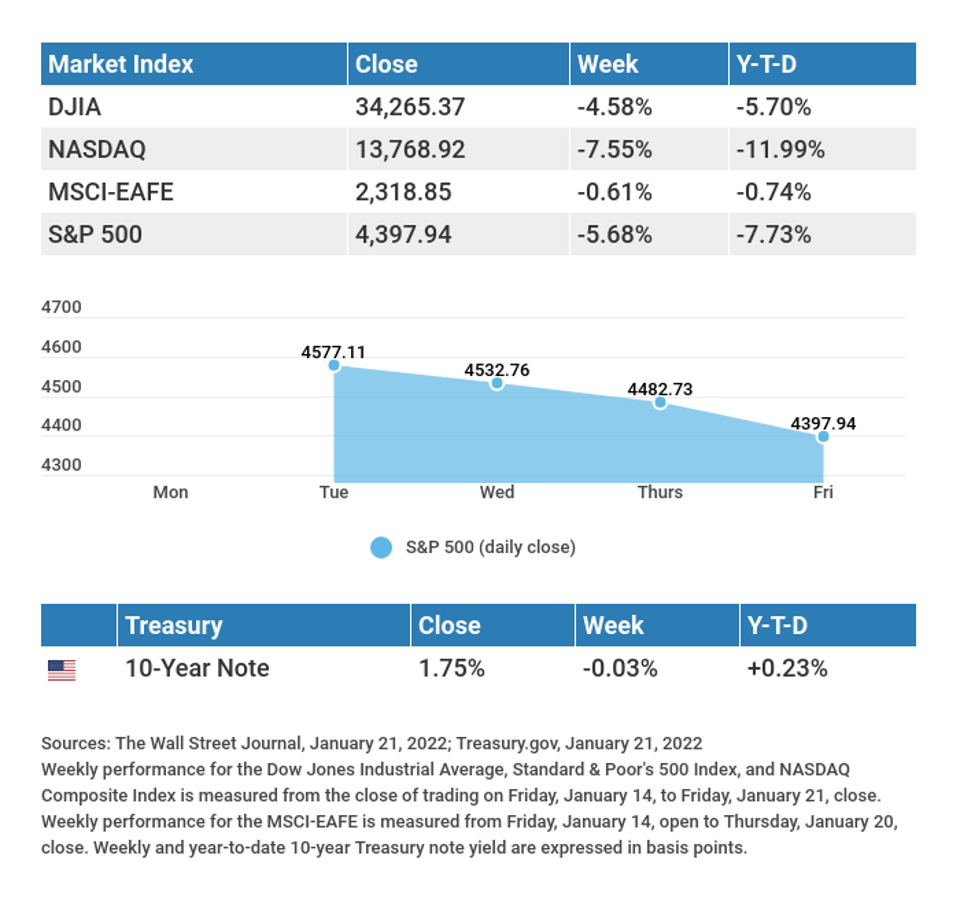In this week’s recap: Stocks sink on rate hike talk.
Weekly Economic Update
Presented by Craig Moore, January 24, 2022
THE WEEK ON WALL STREET
Stocks extended their January retreat as worries over inflation and rising bond yields continued to exert downward pressure on prices.
The Dow Jones Industrial Average slid 4.58%, while the Standard & Poor’s 500 sank 5.68%. The Nasdaq Composite index dropped 7.55% for the week. The MSCI EAFE index, which tracks developed overseas stock markets, slipped 0.61%.1,2,3
ANOTHER TURBULENT WEEK
After the holiday weekend, stocks found little respite from this month’s selling pressures. The week began with the 10-year Treasury yield hitting a two-year high that triggered a broad retreat in stocks, with technology and other high-growth companies bearing the brunt of the losses. The Nasdaq Composite officially entered correction territory and closed below its 200-day moving average for the first time since April 2020.4
Stocks struggled throughout the week, rallying in early trading on both Wednesday and Thursday on solid corporate earnings and stabilizing bond yields, only to end lower on late-day selling. While last year may have been distinguished by “buying on the dip,” this week reflected a different mindset, “selling on the rebound.” Stocks extended their losses in the final hours of the Friday trading session to conclude a difficult week.
RATE HIKE EXPECTATIONS RISE
Recent market volatility has stemmed predominantly from inflation concerns and how aggressive the Fed will be in fighting it. This reaction reflects the market’s pricing of rate hike probabilities, and their estimation of the Fed’s reaction.
Last week’s interest rate futures suggested that investors expect four or five rate hikes this year, up from three to four the previous week. Markets are pricing a 32% probability of 4-5 rate hikes by December and a nearly 28% probability of 5-6 rate hikes by year-end. Of course, the Fed will act independently of the market, but it provides insight into the recent run-up in yields and continuing pressure on high-growth stock valuations.5,6
T I P O F T H E W E E K
If a major financial or life event is coming up on your calendar, talk to a financial professional about it now. See what ideas they may have about how to manage the event.
THE WEEK AHEAD: KEY ECONOMIC DATA
Monday: Purchasing Managers’ Index (PMI) Composite Flash.
Tuesday: Consumer Confidence.
Wednesday: New Home Sales. FOMC Announcement.
Thursday: Gross Domestic Product (GDP). Durable Goods Orders. Jobless Claims.
Friday: Consumer Sentiment.
Source: Econoday, January 21, 2022
The Econoday economic calendar lists upcoming U.S. economic data releases (including key economic indicators), Federal Reserve policy meetings, and speaking engagements of Federal Reserve officials. The content is developed from sources believed to be providing accurate information. The forecasts or forward-looking statements are based on assumptions and may not materialize. The forecasts also are subject to revision.
THE WEEK AHEAD: COMPANIES REPORTING EARNINGS
Monday: International Business Machines (IBM).
Tuesday: Microsoft Corporation (MSFT), General Electric Company (GE), Verizon Communications, Inc. (VZ), Johnson & Johnson (JNJ), Lockheed Martin Corporation (LMT), Texas Instruments, Inc. (TXN), American Express Company (AXP), Capital One Financial Corporation (COF), Raytheon Technologies Corporation (RTX).
Wednesday: AT&T, Inc. (T), Intel Corporation (INTC), The Boeing Company (BA), Tesla, Inc. (TSLA), Abbott Laboratories (ABT), ServiceNow, Inc. (NOW), KimberlyClark Corporation (KMB), Norfolk Southern Corporation (NSC).
Thursday: Apple, Inc. (AAPL), Visa, Inc. (V), Mastercard, Inc. (MA), McDonald’s Corporation (MCD), Northrop Grumman Corporation (NOC), Blackstone, Inc. (BX), Southwest Airlines Co. (LUV), The SherwinWilliams Company (SHW), Mondelez International, Inc. (MDLZ).
Friday: Caterpillar, Inc. (CAT), Chevron Corporation (CVX), ColgatePalmolive Company (CL).
Source: Zacks, January 21, 2022
Companies mentioned are for informational purposes only. It should not be considered a solicitation for the purchase or sale of the securities. Investing involves risks, and investment decisions should be based on your own goals, time horizon, and tolerance for risk. The return and principal value of investments will fluctuate as market conditions change. When sold, investments may be worth more or less than their original cost. Companies may reschedule when they report earnings without notice.
Q U O T E O F T H E W E E K
“Brass shines as fair to the ignorant as gold to the goldsmiths.”
ELIZABETH I

T H E W E E K L Y R I D D L E
A woman sailed into the Bahamas with her boat on the 28th of April. She stayed in the Bahamas for three weeks and then left in April. How is this possible?
LAST WEEK’S RIDDLE: How many times can you subtract the number 4 from 40?
ANSWER: Once. After that, you will no longer be working with the number 40.
Investing involves risks, and investment decisions should be based on your own goals, time horizon, and tolerance for risk. The return and principal value of investments will fluctuate as market conditions change. When sold, investments may be worth more or less than their original cost.
The forecasts or forward-looking statements are based on assumptions, may not materialize, and are subject to revision without notice.
The market indexes discussed are unmanaged, and generally, considered representative of their respective markets. Index performance is not indicative of the past performance of a particular investment. Indexes do not incur management fees, costs, and expenses. Individuals cannot directly invest in unmanaged indexes. Past performance does not guarantee future results.
The Dow Jones Industrial Average is an unmanaged index that is generally considered representative of large-capitalization companies on the U.S. stock market. Nasdaq Composite is an index of the common stocks and similar securities listed on the NASDAQ stock market and is considered a broad indicator of the performance of technology and growth companies. The MSCI EAFE Index was created by Morgan Stanley Capital International (MSCI) and serves as a benchmark of the performance of major international equity markets, as represented by 21 major MSCI indexes from Europe, Australia, and Southeast Asia. The S&P 500 Composite Index is an unmanaged group of securities that are considered to be representative of the stock market in general.
U.S. Treasury Notes are guaranteed by the federal government as to the timely payment of principal and interest. However, if you sell a Treasury Note prior to maturity, it may be worth more or less than the original price paid. Fixed income investments are subject to various risks including changes in interest rates, credit quality, inflation risk, market valuations, prepayments, corporate events, tax ramifications and other factors.
International investments carry additional risks, which include differences in financial reporting standards, currency exchange rates, political risks unique to a specific country, foreign taxes and regulations, and the potential for illiquid markets. These factors may result in greater share price volatility.
Please consult your financial professional for additional information.
This content is developed from sources believed to be providing accurate information. The information in this material is not intended as tax or legal advice. Please consult legal or tax professionals for specific information regarding your individual situation. This material was developed and produced by FMG Suite to provide information on a topic that may be of interest. FMG is not affiliated with the named representative, financial professional, Registered Investment Advisor, Broker-Dealer, nor state- or SEC-registered investment advisory firm. The opinions expressed and material provided are for general information, and they should not be considered a solicitation for the purchase or sale of any security.
Copyright 2022 FMG Suite.
CITATIONS:
- The Wall Street Journal, January 21, 2022
- The Wall Street Journal, January 21, 2022
- The Wall Street Journal, January 21, 2022
- CNBC, January 17, 2022
- The Wall Street Journal, January 18, 2022
- CME, January 19, 2022
